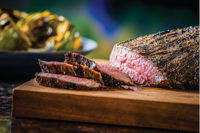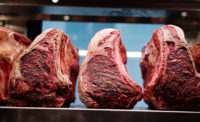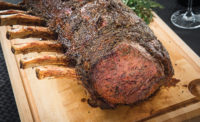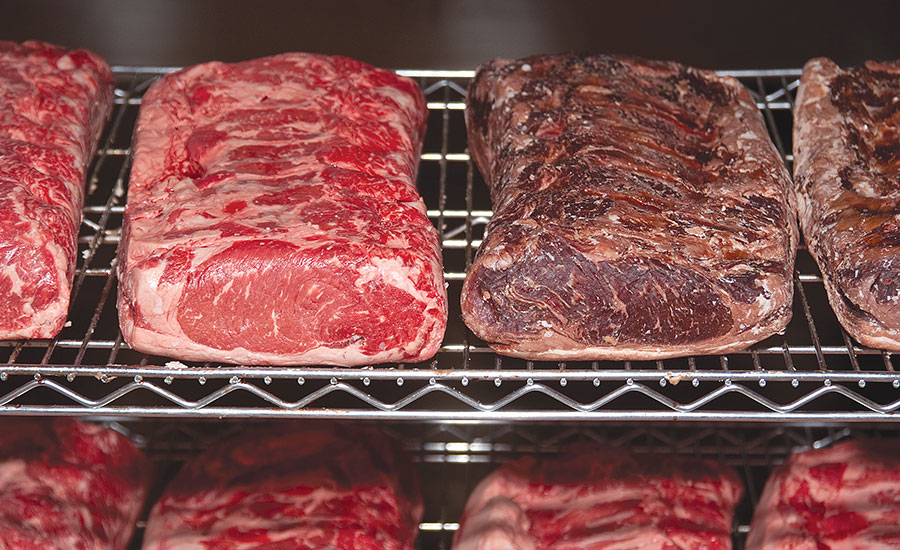Get Real with Beef: Better with age






Growing up, I noticed my folks always had the local butcher hang our harvested beef for a few weeks prior to cutting and wrapping it. Little did I realize then that, like so many things, beef does get better with age. After years of meat science education, research and experience, I have gained a better understanding of the mechanisms of beef aging and differences in eating quality that can be derived from it. Improvements in tenderness are always at the forefront of logic, but flavor profiles can also start to develop as aging time lengthens to where it can enhance the overall palatability of beef, and thus keep consumers coming back for more.
The overwhelming majority of beef produced and sold in North America is wet-aged. Wet-aging is rather precise and consistent, resulting in a high-yielding product that still allows the natural enzymatic breakdown of muscle fibers to improve tenderness. Though now considered the “traditional” means of aging beef, wet-aging is in fact a relatively new concept compared with what was done for generations, before the dawn of commercial vacuum packaging. Until the 1970s, most beef was inventoried in carcass or large, bone-in primal form. But an innovative company, known then as Iowa Beef Processors (IBP), changed the way beef was delivered, and subsequently aged, using vacuum packaging technology on a large scale.
Customers noticed extended shelf life, improvements in overall product yield, smaller and more manageable cuts – and some subtle differences in flavor. This means of beef storage has become commonplace and a widely accepted practice. But what’s happening while that meat is sitting there? Natural enzymes in the muscle are being allowed to break down the muscle fibers at the cellular level, creating a more tender piece of meat.
Though there are a few other endogenous enzymes in muscle tissue that can enhance tenderness, the primary naturally occurring tenderizing enzymes are the calpains. Calpains are activated by the release of calcium in the muscle cell after harvest and act on the structural proteins in the muscle fiber causing a weakening of their structure and, thus, tenderization.
Science is awesome!
After all of this activity at the molecular level, over the course of many days in a refrigerated state, enough of the structure will have been broken down to accomplish tenderness in most cases. The aging enzymes act on the muscle fibers, but not on the connective tissues within and adjacent to the muscles, so some cuts will still require specific cooking or preparation techniques to make them more tender.
It is often thought that aging is only for tenderization, but tender meat is only one of the results of aging; flavor changes occur as well. After the naturally occurring enzymes have done their job, there is a release of some water within the meat due to the natural compromise of muscle cell membranes. As a result, the essence of the beef has been concentrated, and a more robust flavor develops from that concentration of proteins, sugars, minerals, fats and the like.
One more thing: Beef that is wet-aged for an especially long time tends to take on a bit of a sour flavor. Sour, you say? How does this get there – and is it desirable?
Let’s consider the environment in the vacuum package, where there is no air (thus, obviously, no oxygen). No fresh meat is perfectly sterile; there’s always going to be some, albeit very few, microorganisms that make their way in before packaging. It’s a natural part of the process, and most of these safe microorganisms are controlled by the fact that there is no air in the package. A few of them, though, don’t care if they have oxygen. These linger on the meat’s surface and live for a time by converting what little sugar can be found into lactic acid.
That lactic acid – which, rest assured, is completely safe – does two things: It drops the pH on the surface of the meat in the sealed package to a lower level than even those microbes can tolerate; and it creates a slightly sour flavor. Now, how often do we notice that? The answer is, almost never. Unless the beef has been aged to an extremely long point and the conditions are right for extreme amounts of lactic acid to be produced, we rarely notice it. The moment we would actually notice it is when normal wet-aged beef is compared to extremely fresh beef (less than four days from packaging) or if it has been dry-aged.
Dry-aged beef, oh boy!
As a meat scientist, I’m often asked to explain the science of dry-aging. That’s rather hard because there are few controls and the meat is subjected to the open air. I usually reply that I can’t explain the science of dry-aging, but I can use science to try to explain what happens, if that makes sense.
Scientists love wet-aging beef because of all the controls in place, starting with environment. The vacuum packaging and temperature control deliver ever more precision as technology progresses. Dry-aging beef also uses temperature control, but because the meat is allowed to be in open air (in a cooler), the humidity, air movement, microorganism control and countless other variables result in more of an art than a science – but it all adds up to deliver a distinctly different eating experience than wet-aging provides.
Dry-aged beef is not for everyone. Because of the aging process, of course there is some moisture loss and a concentration of flavors, but the big change comes due to the control (or attempted control) of dehydration from the meat being exposed to air. Often, the beef being dry-aged will be in coolers with high-velocity fans to move the air and create a dried crust on the surface of the meat.
Once the crust is developed, the evaporation process slows. Often that crust allows for some fine molds to grow and impart flavors into the meat (similar to the way cheese is made). Dry-aged beef will be different in nearly every location from which it is produced, which gives a unique eating experience each time it is enjoyed. Wherever beef is dry-aged, it is imperative that the raw product going into dry-aging is of high quality to begin with. Plentiful marbling is crucial and it is recommended to work with bone-in cuts to minimize the loss of edible portion when the subprimal is trimmed and cut into steaks.
Whether wet or dry, the aging of whole-muscle beef is recommended — no, it’s a necessity — to maximize its eating potential. Aging will enhance the tenderness, adjust the flavor and help produce a more palatable product in the end. There are many opinions and beliefs involved with aging beef, but many programs require a minimum of 21 days as the “sweet spot.” Dry-aged beef has been aged as little as 14 days up to a radical 100 days. It is important for meat operators to choose the right aging protocol for the taste preferences of their customers.
Looking for a reprint of this article?
From high-res PDFs to custom plaques, order your copy today!









